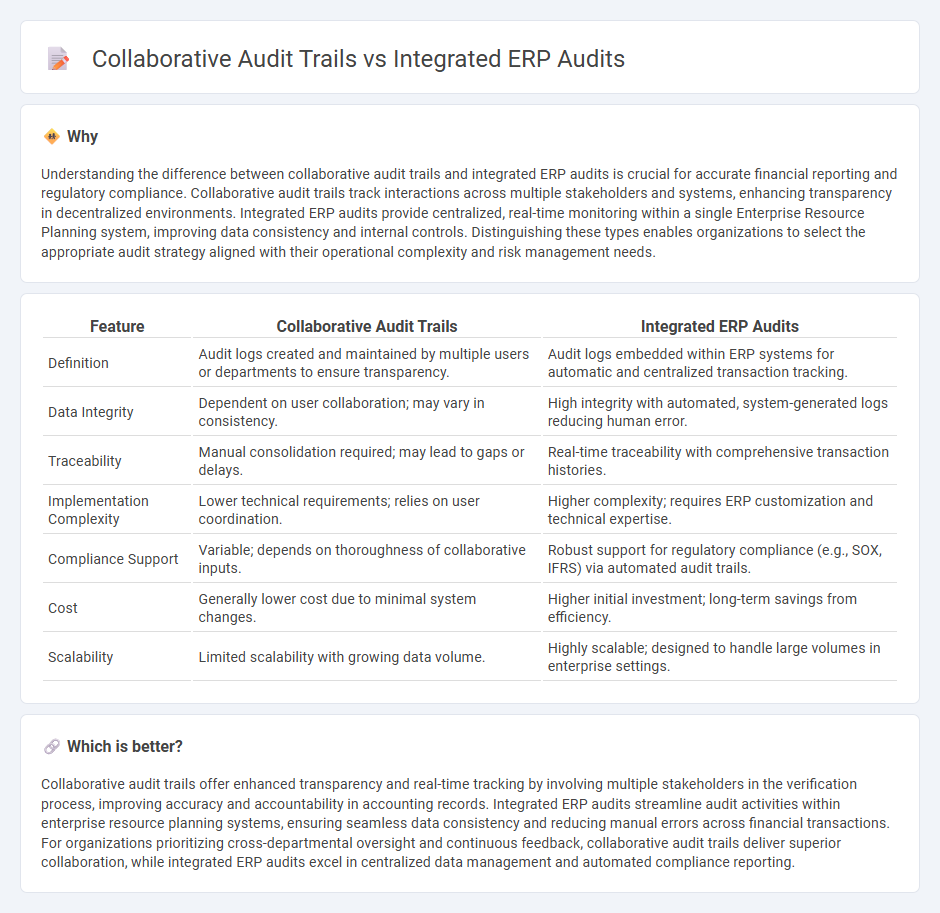
Collaborative audit trails enhance transparency by allowing multiple stakeholders to access and verify transaction records in real-time, improving accuracy and accountability. Integrated ERP audits streamline financial processes by embedding audit functions directly within enterprise resource planning systems, ensuring seamless data consistency and compliance. Explore how combining these approaches can revolutionize financial oversight and risk management.
Why it is important
Understanding the difference between collaborative audit trails and integrated ERP audits is crucial for accurate financial reporting and regulatory compliance. Collaborative audit trails track interactions across multiple stakeholders and systems, enhancing transparency in decentralized environments. Integrated ERP audits provide centralized, real-time monitoring within a single Enterprise Resource Planning system, improving data consistency and internal controls. Distinguishing these types enables organizations to select the appropriate audit strategy aligned with their operational complexity and risk management needs.
Comparison Table
| Feature | Collaborative Audit Trails | Integrated ERP Audits |
|---|---|---|
| Definition | Audit logs created and maintained by multiple users or departments to ensure transparency. | Audit logs embedded within ERP systems for automatic and centralized transaction tracking. |
| Data Integrity | Dependent on user collaboration; may vary in consistency. | High integrity with automated, system-generated logs reducing human error. |
| Traceability | Manual consolidation required; may lead to gaps or delays. | Real-time traceability with comprehensive transaction histories. |
| Implementation Complexity | Lower technical requirements; relies on user coordination. | Higher complexity; requires ERP customization and technical expertise. |
| Compliance Support | Variable; depends on thoroughness of collaborative inputs. | Robust support for regulatory compliance (e.g., SOX, IFRS) via automated audit trails. |
| Cost | Generally lower cost due to minimal system changes. | Higher initial investment; long-term savings from efficiency. |
| Scalability | Limited scalability with growing data volume. | Highly scalable; designed to handle large volumes in enterprise settings. |
Which is better?
Collaborative audit trails offer enhanced transparency and real-time tracking by involving multiple stakeholders in the verification process, improving accuracy and accountability in accounting records. Integrated ERP audits streamline audit activities within enterprise resource planning systems, ensuring seamless data consistency and reducing manual errors across financial transactions. For organizations prioritizing cross-departmental oversight and continuous feedback, collaborative audit trails deliver superior collaboration, while integrated ERP audits excel in centralized data management and automated compliance reporting.
Connection
Collaborative audit trails enhance the transparency and accuracy of financial data by allowing multiple stakeholders to contribute and verify transactions within an ERP system. Integrated ERP audits leverage these trails to streamline compliance checks, ensuring real-time monitoring and reducing the risk of errors or fraud. This connection improves overall audit quality and supports regulatory adherence in accounting processes.
Key Terms
Data Consistency
Integrated ERP audits ensure data consistency by automatically synchronizing transaction records across modules, reducing discrepancies and enhancing audit accuracy. Collaborative audit trails leverage shared access and real-time updates among stakeholders, promoting transparency and timely detection of inconsistencies. Explore how these approaches optimize data integrity and streamline auditing processes for improved compliance.
Access Controls
Integrated ERP audits enhance security by embedding access controls directly within the system, ensuring real-time monitoring and automated compliance checks. Collaborative audit trails facilitate transparency by allowing multiple stakeholders to review access permissions, fostering accountability and reducing unauthorized data exposure. Explore the differences and benefits of both approaches to strengthen your organization's access control strategy.
Real-Time Monitoring
Integrated ERP audits enable real-time monitoring by seamlessly capturing transactional data across finance, procurement, and inventory modules, providing immediate insights into anomalies and compliance risks. Collaborative audit trails enhance transparency and accountability by allowing multiple stakeholders to access, verify, and annotate audit logs concurrently, fostering a comprehensive and dynamic oversight environment. Explore the advantages of combining these methodologies to optimize audit accuracy and operational efficiency.
Source and External Links
Integrated Auditing of ERP Systems - This source outlines the main concepts involved in each major phase of integrated auditing specifically for ERP systems, focusing on the overall audit approach rather than detailed audit programs.
Achieving Compliance and Audit Readiness with ERP - ERP systems automate audit processes, provide real-time monitoring and reporting, integrate with audit management tools, and help organizations meet regulatory standards, making integrated ERP audits more accurate, efficient, and compliant.
ERP Audits: What, How, And When Explained - Integrated ERP audits often combine compliance, security, process, and specialized audits to provide a comprehensive view of ERP system performance, identifying risks, inefficiencies, and opportunities for improvement using real-time insights and automated tools.
 dowidth.com
dowidth.com